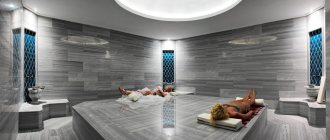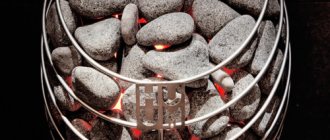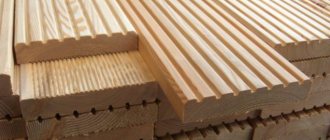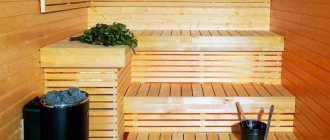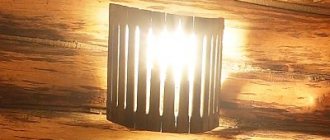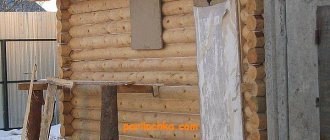The installation of electrical wiring in saunas and bathhouses is one of the most important stages in the construction of this irreplaceable structure, since the safety of the people receiving the procedures depends on the quality of the work and the materials used. In order to avoid mistakes when laying electrical wiring, to select the optimal materials and options for their use, you should consider in detail the nuances and features of the work. In the article we will tell you which wire to use for baths and saunas, and consider the installation features.
Selecting materials for wiring in the bathhouse
The main condition when selecting a cable for a bath or sauna should be its thermal resistance. It is also important to understand that installing sockets of any type in steam rooms is prohibited. A condition for laying wiring is that a grounding loop must be installed.
When selecting electrical wiring, you should understand what rooms are usually available in the bathhouse and their main categories. The bathhouses are divided into two groups:
- rooms with normal temperature conditions, in which it is allowed to lay electrical wiring similar to that found in residential premises;
- rooms in which only heat-resistant cables are allowed, since the temperature in them often reaches 170°C.
Wiring for standard premises
The AVVG cable is suitable for electrical wiring in rooms with normal humidity.
In rooms with normal temperature conditions, it is recommended to use the following types of cables:
- AVVG;
- VVG;
- NYM;
- PVS.
Any of the above types of cables can be laid during installation either in a hidden way or on top of walls. The main and only condition for their use should be the increased requirements for wire insulation, since most often the construction of a bathhouse or sauna is made of wood. For cable insulation, cross-linked polyethylene, PVC and other polymer materials with the required properties are used.
The following cable brands are suitable for installing and connecting lighting devices:
- PPGng-HF 3x1.5;
- VVGng-LS 3x1.5;
- NYM 3x1.5.
To install sockets, the wire must be selected with a cross-sectional area of at least 2.3 mm2.
Decoding the abbreviation
The wire marking contains five letters, but first we should talk about the missing letter A, which indicates the copper strands of the wire. The letters present in the markings are interpreted as follows:
- P - rubber insulating material.
- K - insulation is made of silicone material (silicone).
- G - flexible wire of unarmored type.
- M - fiberglass outer braid. The material is impregnated with heat-resistant silicone varnish or enamel.
The design features of the wire can be seen in the picture below.
RKGM cable
Note! It is more correct to call RKGM a wire rather than a cable.
Wiring in steam rooms
In the steam room, it is allowed to use only heat-resistant cables that have a sufficient level of resistance to high temperatures. This is due to the fact that even with the slightest deformation of the insulation there is a high risk of fire.
The following types of cables are available on the modern market, suitable for use in steam rooms:
- RKGM 1x2.5;
- PVKV 1x2.5;
- PRKS 3x2.5;
- PMTK 3x2.5.
Tip #1. If we consider foreign-made cables, then for electrical wiring in the steam room you can use Olflex Heat 3x2.5. However, the cost of such a wire is significantly higher than its domestic counterparts.
Wire connections should only be made in boxes protected from moisture.
Subtleties of design
RKGM is manufactured in strict accordance with the current TU16.K80-09-90. The wire is single-core, made of copper, has flexibility from the fourth class according to the GOST 22483-77 classification.
The current documents document the correspondence of the core cross-section (nominal parameter) with the actual wire cross-section. For example, the thickness of a core per “square” is 0.31 mm. This means that the wire must contain three or more wires.
RKGM elements:
- INSULATION. Above the copper core there is a special insulating layer made using organosilicon rubber. Today the material has a simpler name - silicone rubber or SiR. The advantage of RKGM insulation is its high level of flexibility, resistance to high temperatures and stretching. To make heat-resistant wire, a composition is used that maintains parameters over a wide temperature range - up to 200 degrees Celsius or more. Today, silicone insulation is actively used for special fire protection wires that can withstand high temperatures up to 950 degrees Celsius. The insulation thickness varies according to the rated voltage.
- OUTER SHELL. On the surface of the product there is a braid made of special threads with a fiberglass structure and impregnated with a special type of varnish KO-921. This approach guarantees high fire resistance and increased strength. This type of varnish includes a glyphthalic composition and silicone resins. The use of impregnation guarantees the resistance of the wire to high temperatures (up to 250 degrees Celsius). In general, the cable insulation belongs to class H according to GOST 8865-93 and successfully withstands temperatures of 180 degrees Celsius.
This combination makes the heat-resistant wire RKGM an invariable assistant in situations where flexibility, unpretentiousness and the ability to work in a wide temperature range are required.
Requirements for wiring in the bathhouse
Before proceeding with installation, it is necessary to study and strictly follow the rules for laying electrical wiring in baths and saunas:
- cables must be laid only vertically or horizontally;
- if rotation is necessary, it must be arranged strictly at an angle of 90°;
- horizontal wiring lines should be placed at a distance of 10-20 cm from the ceiling and run parallel to it;
- the distance from the laid cable or switches to the window or door must be at least 10 cm;
- the cable must be located at a distance of at least 0.5 m from heating radiators and other metal devices;
- switches are placed from the floor at a distance of at least 1 m, sockets - 0.3 m;
- sockets and switches are located from the shower stall at a distance exceeding 0.6 m;
- the line from the distribution panel to the electricity consumers should be laid only with a single piece of wire - any connections are prohibited;
- Wiring connections may only be made in junction boxes that have a high level of protection from moisture;
- The electrical panel is placed as close as possible to the point of entry of the supply cable into the bathhouse building.
Basic requirements
Let's move straight to the key standards. They are designated by experts, craftsmen and experienced hosts. Only by complying with these standards can safety and comfort in the sauna be guaranteed.
- The circuit diagram of the electrical panel must be supplemented with RCDs and circuit breakers. In this case, it is recommended to set operating current limits to a maximum of 30 mA, and the optimal value will be 10 mA.
- When the bathhouse is made of wood, it is advisable to do the wiring in an open type. It is placed in steel or copper pipes, in a PVF cable, as well as in special channels made of durable plastic. A hidden wiring system is more suitable for baths made of non-combustible materials. For example, it can be brick, cinder blocks, as well as foam blocks and other building materials.
- For the steam room, cables with reliable insulation are suitable, which must have exceptional resistance to extremely high temperatures.
- A good option is to install lamps in the corners, but do the wiring in the adjacent room. In this case, the wires are fed directly through the wall.
- In other rooms of the bathhouse, it is best to route cables along the shortest paths. Let's say this applies to lamps.
- It is strictly prohibited to run electrical wires directly above the stove.
- When you need to run a cable through walls, you must use a pipe made of durable metal.
- The wires are combined by welding and soldering, and crimped with sleeves. Terminal connections are also used. Twisting is strictly prohibited here.
Grounding is a mandatory measure. Lightning protection is very desirable, although it is not considered mandatory. However, it is better to take care of safety one hundred percent.
Wiring: useful tips
Let us dwell in more detail on several proven tips regarding the installation of an electrical system in a bathhouse or sauna.
- The first recommendation concerns the installation of an outlet or switch. It is necessary to provide a special protective plate made of non-flammable material. Of course, not everyone considers this measure so important, since now such products are already made of plastic, in addition, they are equipped with plastic back walls. But still, such additional protection is needed: it will not harm, it guarantees safety.
- It is extremely important to correctly select a sufficient cross-section size. It must comply with all electrical appliances installed in the bathhouse premises. Let's say the owners install stoves and electric heaters there. The cross-section must have a good margin in order to easily withstand heavy loads.
- If a cable with an ng-LS insulation level is used, then it is allowed to leave it in the cable channel without laying protective plates between it and the wall. In all other cases, additional fireproof protection is necessary: you will need to lay a strip of fireproof material. You can remove the wires from the wall surface to a minimum distance of 10 mm.
With basic tips, it is possible to make the electrical wiring system safer, more reliable, and resistant to increased loads and adverse operating conditions.
Cable connection methods
The VVG cable is suitable for supplying power to the bathhouse building without restrictions.
Before installing the internal electrical wiring, you need to connect the power cable to the building. Eyeliner is carried out in two ways:
- underground;
- air.
The advantages of the air method are obvious: low cost and labor-intensive work, high installation speed. Most often, SIP-4 cable is used for these purposes. It is important to know that laying SIP cables is not allowed in the attic, and therefore for a bathhouse it is better to choose wires of the VVG or NG brands.
When fastening to an external wall, the cable should be placed in a plastic box or corrugated. At the entry point into the room you need to place a box with circuit breakers. Laying the cable below ground level is an expensive and time-consuming method, but at the same time it provides more reliable protection of the cable from damage. When choosing an underground connection, it is recommended to use VB6Shv cable.
VB6Shv cable is an excellent choice for underground installation to a bathhouse
Installation of wiring and devices in a bathhouse or sauna
Before installing a heat-resistant cable, you should calculate the power required for the normal functioning of each of the devices consuming electricity. In accordance with the calculations, a cross-section of a heat-resistant cable is selected that can withstand the design load.
To operate lighting in a bathhouse, a power of 1-2 kW is sufficient, but it should be taken into account that when installing additional electrical appliances, the power will increase. Baths heated by an electric furnace require a power of at least 10 kW for normal operation.
When installing any electricity consumer in a sauna or bathhouse, you should remember the electrical safety rules and turn off the circuit breakers in the distribution panel. The purchase of sockets, switches, lighting devices and the cables themselves must be done only in specialized supermarkets or stores. Thus, the likelihood of purchasing defective or counterfeit products is significantly reduced.
Suitable types of cable or wire
Those who believe that the wire for a steam room in a bathhouse should be specific think correctly. Its main task is to withstand high temperatures. The PUE, as you remember, speaks of the upper limit of the range of 170 degrees.
You should find out this point when purchasing the cable in the store.
You need the following brands: PRKS and RKGM. The wire cross-section can be calculated based on the expected load.
Go to this article - there is a section calculation table. What are PRKS and RKGM? These are copper cables with silicone insulation that can withstand high temperatures.
PRKS can withstand a temperature range from -50 to 180 degrees with humidity up to 98% . The manufacturer himself recommends it for use in saunas and baths.
In principle, wires are included with the stoves, but it is worth keeping in mind that PRKS comes with different cross-sections, including those capable of withstanding up to 30 kW of load.
RKGM an outer fiberglass braid. Its characteristics are approximately the same: temperature range from -60 to 180, will withstand 100% humidity at temperatures up to 35 degrees , and is resistant to combustion.
As you can see, these are really suitable brands of cable for a steam room in a bathhouse.
Installation of wiring in the sauna
As mentioned above, in a bathhouse or sauna the cable can be laid in both open and closed ways and covered with various protective elements. Despite the fact that the closed method is considered more preferable, there are some nuances in its implementation.
According to the requirements of the PUE and SNiP, laying electrical wiring in metal corrugations and tubes is not allowed. Also, wires sheathed with metal-containing materials should not be used. This ban is due to the fact that a bathhouse is a place with high humidity, and metal, like no other material, is susceptible to corrosion processes.
Properties and characteristics
Due to the fact that the wire is equipped with additional protection and has a coating that prevents ignition and also getting wet, the service life of the wire is several times longer than the service life of ordinary cables. The protective coating is resistant to mechanical damage, bacterial or chemical destruction. The presence of a layer of waterproof materials prevents the formation of fungus and mold. Work at maximum humidity - up to 100%. There is greater resistance to high temperatures than to sharply negative ones. Exposure to sub-zero temperatures above those specified in the instructions can lead to cracking of the coating. Therefore, when purchasing a product, it is necessary to take into account the requirements for operation. Product characteristics are different and individual for each individual type of cable.
Installation of switches and sockets
Once the cable installation is complete, you can begin installing switches and sockets. These electrical network elements can be installed in any room except the steam room itself.
Also, switchboards should not be placed in rooms with high humidity. In addition to steam rooms, this ban also applies to showers. All other premises are allowed to be equipped with electrical elements without any serious restrictions.
Sockets in the bathhouse, regardless of the installation location, must be installed in a waterproof design
Lighting system installation
After laying the heat-resistant cable, in addition to sockets and switches, you can install lighting fixtures. Standard light bulbs and lamp shades are not suitable for a bathhouse due to high temperatures and humidity. Therefore, in order to avoid rapid failure and possible fire, you should select heat-resistant lamps.
The lighting devices installed must be sufficiently sealed so that steam and splashes of water entering the housing cannot lead to a short circuit and subsequent fire. Also, if steam gets on the lampshade, the device may heat up unevenly, become deformed and even burst, which will lead to serious injuries to people taking bath procedures. When installing the lighting system, you should take into account that the light in the steam room should not be too bright. Most often, matte lampshades with light bulbs up to 60 W are used.
Tip #2. It is recommended to place lamps on the ceiling closer to the corners of the room, since in these places the air temperature is slightly lower than in the central part of the ceiling.
Light
The minimum number of light sources in the room is one source. But considering that the recommended power of an incandescent light bulb in a steam room is only 60 W , you may decide that one point will not be enough. At the same time, today there is no longer any need to limit yourself to incandescent light bulbs - there are many other ways to illuminate a steam room. Although... in fact, here, with certain limitations, you can also use halogen and LED light sources.
For some reason unknown to us, the fact that a properly installed RCD (say, 30 mA, capable of protecting a person) should be enough to stop worrying about the danger of 220V in a steam room is ignored in disputes over LED lighting. But more on that later.
Installation diagram
Most often, the scheme for installing light in a steam room is based on the fact that it is safest to place light sources in the corners, above the shelves, and additional ones - under the shelves. If LED lighting is used, it is usually placed behind the back of the shelves and lower, under the shelves, where it is cooler. Under the shelves you can place not only LEDs, but any other suitable lamps.
Of course, you should not install a light source for a steam room in a bathhouse in close proximity to the stove. In my opinion, there shouldn’t be anything next to it except heat-insulating materials - we mean protecting the wall and floor. The distance from the stove to the nearest unprotected surface, as you know, is at least half a meter .
Lamps
We have devoted several articles to lamps on our website - this includes an analysis of their components, a detailed story about the types of heat-resistant lamps for saunas, and clarification of the question of whether a Russian bathhouse needs special lamps.
Of course, lamps for a bathhouse and a steam room are different.
Only in a steam room you need to adhere to certain restrictions related to the heat resistance of the materials and which they are made of. For example, you should give up plastic - it may not break as much as glass, but it melts at high temperatures.
In the bathhouse you can put any lampshades and shades that you like. In the washing room, of course, you put what you would put in the bathroom, but otherwise it’s the same as in an apartment.
But very specific lamps are placed in the steam room:
- they must have a ceramic base - it is non-flammable and tolerant of heat;
- a lampshade made of glass, preferably heat-resistant;
- sealing gasket made of silicone, which does not collapse under the influence of temperature and protects the inside of the lamp from water ingress.
Inside such a lamp you can put a regular incandescent lamp or a 220V LED lamp. If you make a little adjustment, you can put LEDs on a plate, purchased separately.
LED bulbs
Another type of lighting in the steam room is LED strips . They are chosen with a protection class that will protect them from damage due to direct exposure to water. The tapes are placed so that their light does not hit the eyes, and so that the placement location is the coolest in the steam room - this is a small height from the floor, for example.
To power LED strips, you need a driver (aka power supply) or transformer , because the strips are usually powered from a 12-volt network. The main argument here is not that it is beautiful, but that the voltage is safe. This is true, but it was already said above that with an RCD or automatic circuit breaker there is no reason to be afraid of 220 V.
On sale you can find ordinary LED lamps that are powered from a 220V network; they have a standard base that allows them to be screwed into sockets for ordinary incandescent lamps.
You will find details about the types and features of installing LED lamps for a steam room in a bathhouse in this article.
Electrical voltage in the sauna
Also, the owner of the bathhouse must select the voltage to provide the structure with electricity. The reason for this is the fact that heat-resistant cables for baths and saunas can be laid together with a home network with a voltage of 220 V. To make a connection, a number of PUE conditions must be met:
- the electrical wiring line must be reliably protected by placing automatic blockers or automatic machines;
- The power supply to the bathhouse must be carried out with the mandatory installation of grounding type TN-CS;
- The sauna electrical system should not operate without a potential equalization system.
Automatic box for turning off the power supply to individual rooms of the bathhouse
If it is not possible to fulfill the three conditions described above, the supply of electricity to the bathhouse building should be carried out through a voltage-reducing transformer, for example, YaTP-0.25 220/36V. The placement of such a device should be provided outside the building.
Mistakes when choosing a cable for a bath
- A common mistake is placing control equipment in the steam room that is not built into the electric heater. If such a mistake has already been made, then the PUE requires the installation of a limiter that turns off all equipment when it reaches a temperature of 140°C. In this case, the electric furnace will automatically turn off.
- Also a serious mistake should be the presence of connections, breaks and twists in the cable in the steam room or shower. This is very dangerous, since the presence of deformed and damaged insulation is fraught with a short circuit and a high probability of subsequent fire.
- Many people, to reduce the cost of work and reduce the cost of materials, run the power cable directly above the furnace. This method of wiring is strictly prohibited, since even a heat-resistant cable in this area will be constantly exposed to heat.
- 25 mistakes when installing electrical wiring
- Technical characteristics of PRKA wire
- Application, technical characteristics and installation of RKGM wire
- SIP wire: purpose, technical characteristics, installation
- Technical characteristics of PV-1 wires
The use of electric heaters for baths
There are many supporters of heating a bathhouse the old fashioned way, with wood. But there are more and more people who want to steam with greater comfort, while putting a minimum of effort into preparatory operations. To do this, the water for the bath and the air in the steam room are heated with electricity.
For these purposes, either one device is used, or different ones. In the first case, an electric oven is installed in the steam room, heating both the water for washing and the air. In the second, the stove heats only the air, and a conventional boiler installed in the dressing room is used to produce hot water. If you have a boiler, a water supply system is required. There are other options, such as using an external storage tank.
Boiler in the dressing room
The installation location of the electric heater in the steam room belongs to zone No. 1. Apart from it, nothing should be there, but what about the power cable? Let's remember about the traditional method of heating with wood: after all, they are thrown not from the steam room, but from the dressing room. It’s the same with electricity: the cable is connected to the electric heater on the side of the steam room.

